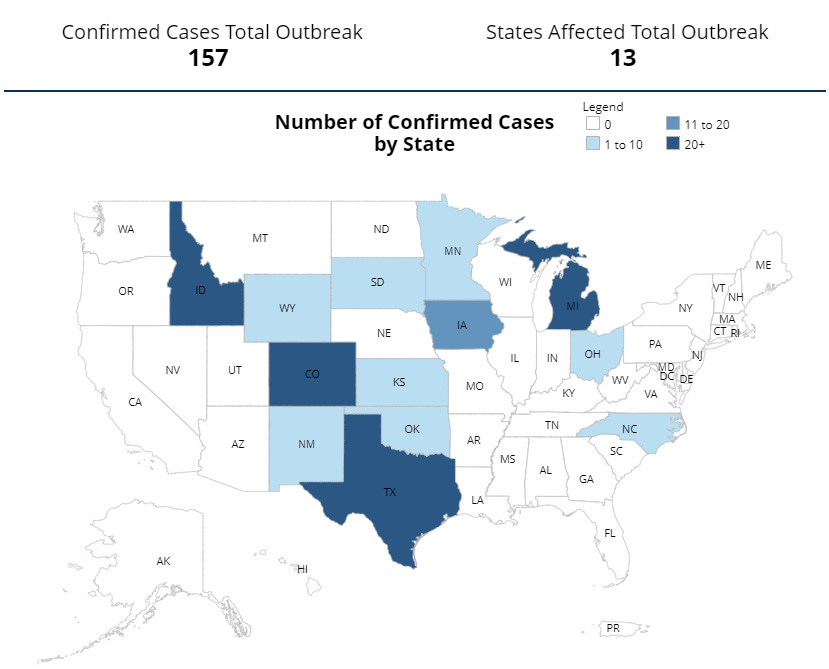What’s new with bird flu?
Pandemic potential remains low despite 9 cases* of H5N1 in humans for 2024, but the situation is still evolving.
Those Nerdy Girls is your trusted source for all things health. Whether there’s too much information, not enough information, or lots of misinformation, we have you covered. Help us keep the lights on by becoming a paid subscriber today.
This information is up to date as of July 16, 2024 at 5 pm EDT.
Pandemic potential remains low despite 9 cases* of H5N1 in humans for 2024, but the situation is still evolving.
“...if we can’t iron out the differences between agriculture and human health… [a more severe virus is] not going to be a good situation." Amesh Adalja, JHU Center for Health Security
Cattle infected with H5N1 now spread across 13 states, with 4 human cases* from cows and 5 cases* from poultry (5 were reported in CO on 7/12, one occurred in the same state back in 2022). The spread is likely bigger than the official numbers since testing all cows is both logistically and politically difficult. This is both good and bad news: despite the spread, only a few humans have been infected, all with mild illness. But unrestrained infections in animals that have close contact with humans could lead to changes in the virus that make it more transmissible.
*All are H5 flu; 5 confirmed as H5N1, 4 are presumptive
HPAI Confirmed Cases in Livestock | Animal and Plant Health Inspection Service (usda.gov)
The current threat of infection to humans who do not work in agriculture is very low. Fortunately, the human cases have all been mild and were effectively treated with antivirals. But if humans or other animals become infected with H5N1 and another flu virus at the same time, the risk of infection to the general population increases.
The scenario of greatest concern is an animal with both H5N1 and our seasonal flu, which, unlike H5N1, is very transmissible in humans. An animal with both H5N1 and H1N1 has the potential for viruses to swap genes, resulting in an H5N1 virus with increased risk of transmission. This is a worst case scenario, like when virus mixing led to the 2009 swine flu pandemic. This is what scientists will be keeping an eye on when flu season picks up speed in the fall.
Dr. Paul Offit makes an excellent argument on why H5N1 is unlikely to lead to a pandemic:
In the last 100 years, the flu subtypes that have caused pandemics have all been H1, H2, or H3, not H5.
In the past 20 years, two outbreaks and scattered infections of H5N1 have not led to sustained human-to-human transmission (an infected human infecting more than a few people).
While H5N1 can cause pneumonia or pink eye in humans, it doesn’t bind well to the nose or throat. Without the ability to multiply there, human-to-human spread is unlikely.
H5N1 Recap:
Traditional vaccines are available in limited supply
mRNA vaccines are in Phase I trials
Antivirals are available
Beef likely has the same safety profile as pre-outbreak (follow safe cooking guidelines, as always)
Pasteurized milk is safe
Raw milk could contain live virus (in addition to bacteria) that could make you sick
Shared equipment or personnel traveling between farms might be leading to transmission
PPE is recommended and being provided to agricultural workers, but it’s HOT out there
National restrictions on dairy cow movement are in place, with some states enacting stricter recommendations
What’s new:
For agricultural fairs, the USDA is requiring dairy cows to be tested within 7 days of movement out of state
Clinicians are testing patients who have flu symptoms regardless of history of animal contact (testing for flu typically does not happen over the summer)
Stanford’s Wastewater SCAN dashboard identifies not only Flu A but also specifically H5N1 detection (CA shows up on the dashboard while not in the official USDA count)
While the situation continues to evolve, this Nerdy Girl is hopeful seeing the steps laid out, the major players involved, and the investigations taking place. Even after COVID-19, we have much to learn about pandemic preparedness, and any outbreak is an opportunity for public health experts to hone these skills.
Previous updates in this series:
Avian flu update – May 3, 2024
Avian Influenza (H5N1) Update – May 8, 2024
Avian Influenza (H5N1) Update – May 15, 2024
Is it safe to eat beef, given the avian flu outbreaks in cows?
Two new reported cases of H5N1 in humans
In the news:
Is ‘cow flu’ here to stay? Three months after it emerged, fears are growing
JHU Center for Outbreak Response and Innovation Novel Highly Pathogenic Avian Influenza A Factsheet
Reminder that we now have an online store filled with amazing nerdy merchandise.
Your purchases will help financially support the science communication mission of Those Nerdy Girls.
P.S. We’d love to see pics of you and your friends and family sporting their new TNG swag. You might even be featured in our shop! Email us your pics at info@dearpandemic.org
Like what you read? Please share it with others!
If you have a question, let us know!
We read every question and use them to inform our upcoming content, though we are unable to respond to each specific question.




